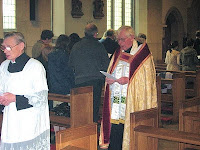Wednesday, July 21st.
This evening I visited the other St Mary's in Barnard Castle. It is quite strange that in this town, within a few hundred yards of each other, there are two churches named after St Mary, the Mother of God. This 'other' St Mary's is the Church of England church, close by the Butter Market in the main street. I do not know its full history, but the original building goes back to twelfth century - how much of this original church still stands I do not know, but the present church is ancient enough. In the past few months a huge amount of work has been done on the church re-organising the interior, and the service on Wednesday evening was to rededicate those parts which had been worked on. The central part of the nave was filled with people, about sixty in all, I think, but the side aisles were empty.
The organ had already been refurbished and dedicated. The present re-ordering of the church-space included the making of a servery (an open space at the back of the nave), the nave itself, the baptistery (in the north transept), St Margaret's Chapel (a place for quiet prayer, off the north transept), the labyrinth (in the south transept), the aumbry (to the left of the altar-table) and the vestry. Pretty much everything! The service was led by the (Anglican) Bishop of Jarrow. In his sermon he hoped that the new servery would emphasise the need for true Christian hospitality and the labyrinth would lead seekers to find their way to God. Each of these refurbished areas was then blessed by the Bishop.
How different the changes have made the Church, I cannot say because I do not know what it was like before the changes were made. But I could not help wondering if the Anglicans were doing what many Catholics have also been doing (even in my Church) - making use of space that is now available because of falling congregations. When I first entered the Church, I could not help thinking that the altar-table would look much better if it had a proper tabernacle resting on it; the new aumbry at the side was the place for the Reserved Sacrament, but the blessing pronounced by the Bishop spoke of the aumbry as a place "in which we place the tokens of Christ's passion". Not really a ringing endorsement of the Sacrifice of Calvary and of the Real Presence. Personally, I do not like the idea of serving tea and coffee and glasses of wine in a place which is dedicated to the worship of God, no matter how much it helps Christian hospitality.
















































